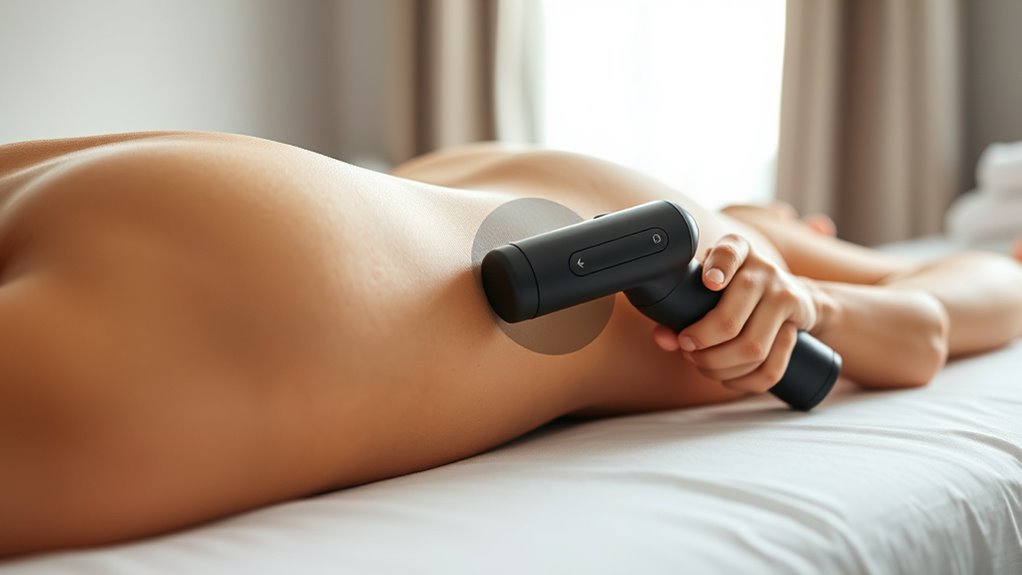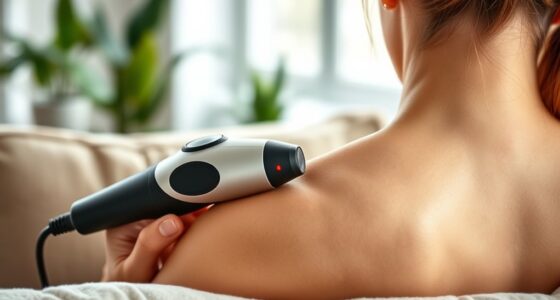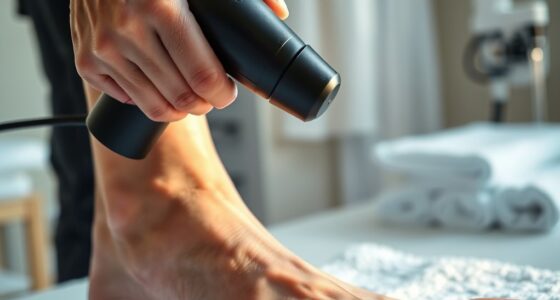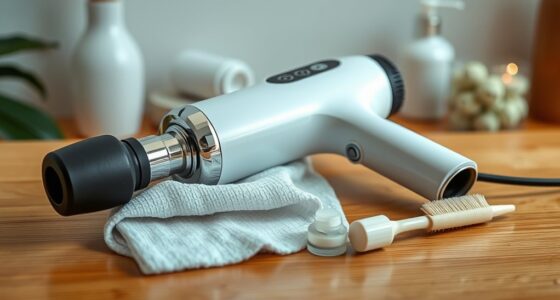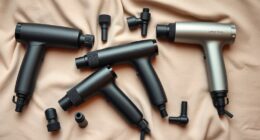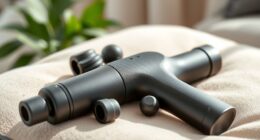To beat sciatica safely with a massage gun, start with low intensity and gentle pressure, targeting muscles around your hips, thighs, and buttocks while avoiding bony areas or the lower back. Use slow, small circular motions and limit sessions to 1-2 minutes per spot. Watch for discomfort or numbness and stop if symptoms worsen. For effective relief, combine this with other therapies—learn more about safe techniques and strategies to ease nerve pain.
Key Takeaways
- Use gentle pressure and start with low intensity to avoid overstimulating irritated nerves.
- Target muscles around hips, thighs, and buttocks, avoiding spinal and bony areas for safety.
- Limit sessions to 1-2 minutes per area and monitor body response to prevent overuse.
- Combine massage gun therapy with heat, stretching, or professional treatments for comprehensive relief.
- Educate yourself on proper technique and stop use if pain, numbness, or discomfort worsens.
Understanding How Massage Guns Impact Nerve Pain
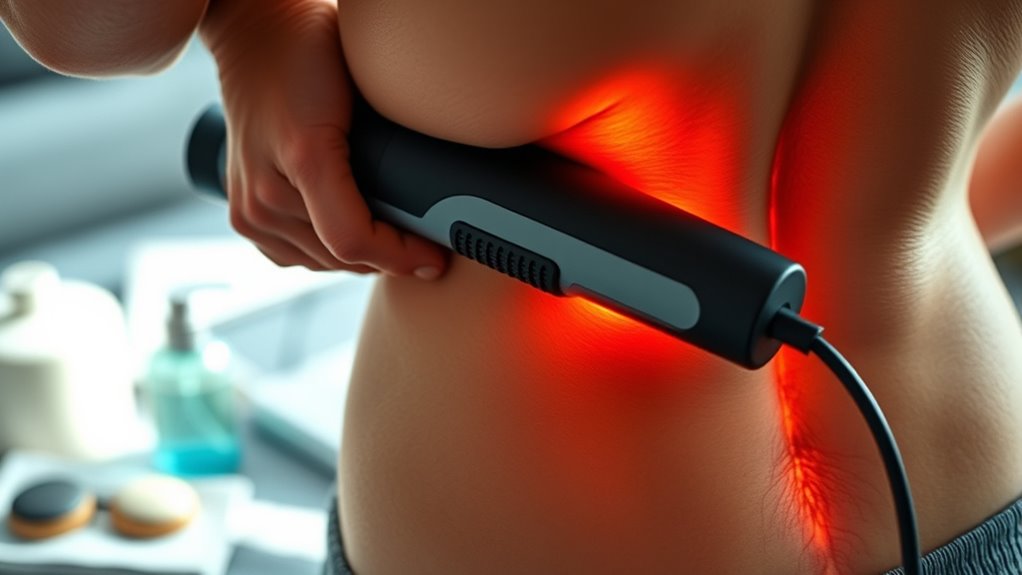
Massage guns can provide targeted relief by stimulating muscles and soft tissues, which may help reduce nerve pain associated with sciatica. When used properly, they can influence nerve sensitivity, helping to calm irritated nerves. The effectiveness largely depends on your massage technique, such as applying gentle pressure and avoiding direct contact with the nerve itself. By focusing on surrounding muscles, the massage gun can improve circulation, ease muscle tension, and decrease pressure on affected nerves. This can lead to a reduction in nerve pain signals, providing relief. Additionally, understanding headphone compatibility and proper device setup can help ensure you use your tools safely and effectively—whether for relaxation or pain relief. Remember, understanding how your nervous system responds to different massage techniques is key—start slow, listen to your body, and adjust your pressure accordingly for safe and effective pain management.
Choosing the Right Massage Gun Settings for Sciatica
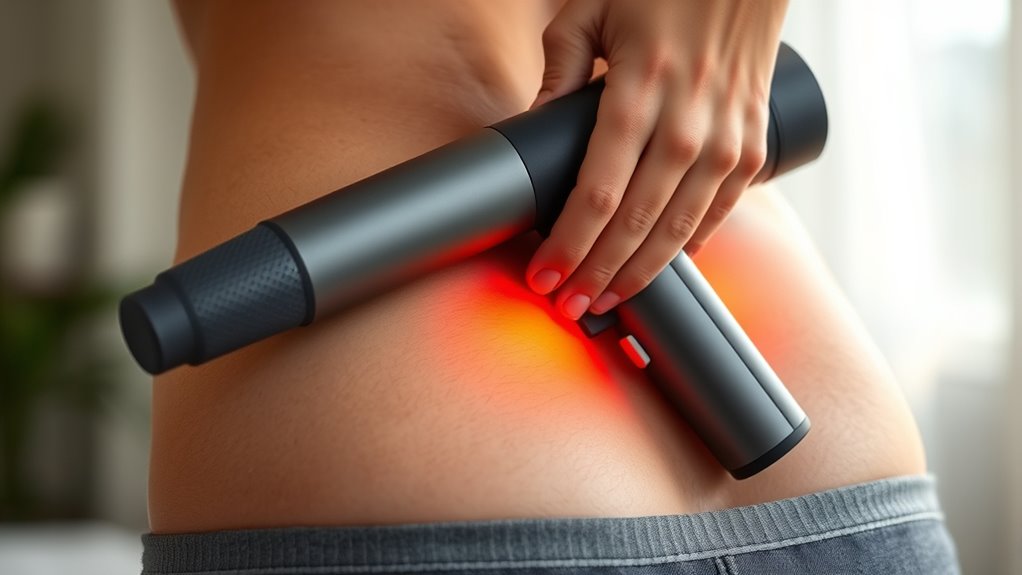
Choosing the right massage gun settings for sciatica is essential to guarantee safe and effective relief. Start with lower intensity to avoid overstimulating sensitive skin or aggravating trigger points. Gradually increase the speed only if you feel comfortable. Use these tips:
- Adjust intensity based on skin sensitivity—if you notice discomfort, lower the speed.
- Target trigger points carefully—apply gentle pressure and avoid overdoing it.
- Monitor your response—stop if pain worsens or if you experience numbness.
Always listen to your body and avoid pressing directly on the nerve or inflamed areas. Proper settings help prevent irritation and ensure you get relief without risking further pain. Remember, gentle, controlled movements are key to safe and effective sciatica treatment.
Identifying Safe Areas to Target During Treatment
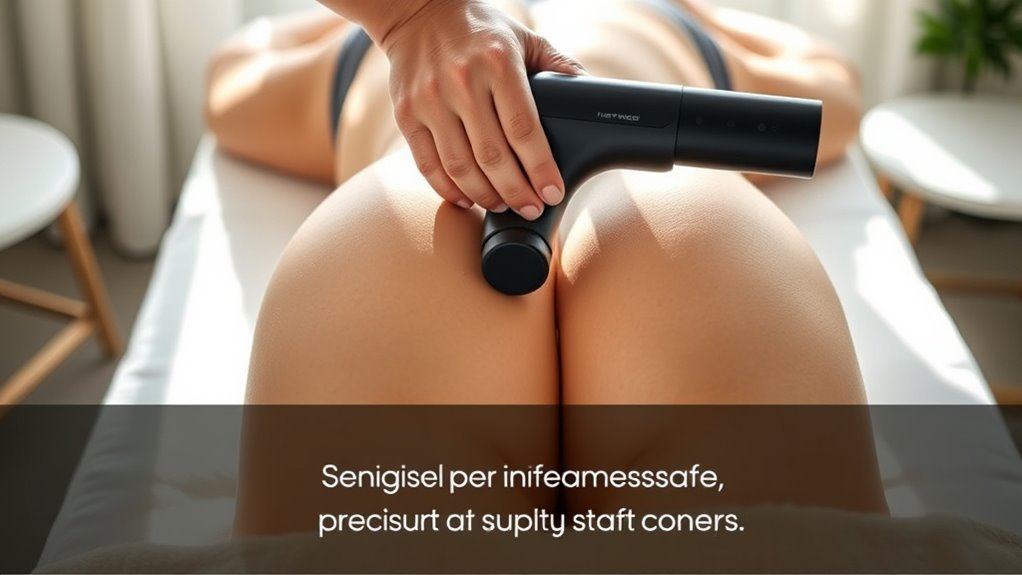
When using a massage gun for sciatica, focus on the surrounding muscle groups rather than the spine itself. Stay clear of spinal areas to avoid irritation or injury. Instead, target painful zones and nearby muscles that can help alleviate pressure and discomfort. Incorporating muscle relaxation techniques can further enhance relief and prevent tension buildup.
Focus on Muscle Groups
To guarantee safe and effective treatment with a massage gun for sciatica, it’s essential to target specific muscle groups while avoiding sensitive or risky areas. Focus on muscles around the hips, thighs, and buttocks, where trigger points often contribute to nerve pain. Proper targeting promotes muscle relaxation and alleviates pressure on the sciatic nerve.
Here are key areas to focus on:
- Gluteal muscles – release tension and reduce nerve impingement.
- Hamstrings – relax tight muscles that can aggravate sciatic pain.
- Hip muscles – alleviate tightness that may compress nerve pathways.
Stay mindful to avoid spinal areas and sensitive regions. Concentrate on muscles that, when relaxed, help ease nerve pain without risking nerve or spinal injury. Utilizing GMC tuning techniques can also inspire insights into precise muscle targeting and safe treatment practices.
Avoid Spinal Areas
While using a massage gun for sciatica, it’s crucial to avoid targeting the spinal area directly, as this region is sensitive and prone to injury. The spine’s delicate structures require extra care to maintain spinal safety. Direct pressure on the vertebrae or spinal cord can worsen nerve sensitivity and cause discomfort or damage. Instead, focus on surrounding muscles and soft tissue areas that support the spine. Keep the massage gun away from the midline and bony prominences, especially in the lower back. By respecting these boundaries, you reduce the risk of aggravating nerve pain. Always remember, staying clear of the spinal area ensures a safer, more effective treatment while minimizing the potential for nerve irritation or injury. Additionally, understanding the importance of contrast ratio can help in selecting appropriate equipment to optimize comfort during therapy.
Target Painful Zones
Instead of targeting the spinal area directly, focus on identifying and treating the muscles and soft tissues that cause pain or discomfort. Look for trigger points—knots or tight spots in muscles—that contribute to sciatica. Gentle fascia release can help loosen connective tissues, reducing nerve compression. To safely target painful zones, consider these areas:
- Gluteal muscles, especially around trigger points
- Hamstrings and piriformis for fascia release
- Lower back muscles that may be tight or tender
Avoid applying pressure directly over nerves or bony structures. By focusing on these soft tissue areas, you can effectively alleviate pain while minimizing risks, ensuring a safer, more targeted massage gun approach. Sound healing science indicates that gentle vibrations can promote cellular regeneration and relaxation, making them a useful addition to treatment.
Techniques for Gentle and Effective Use of Massage Guns
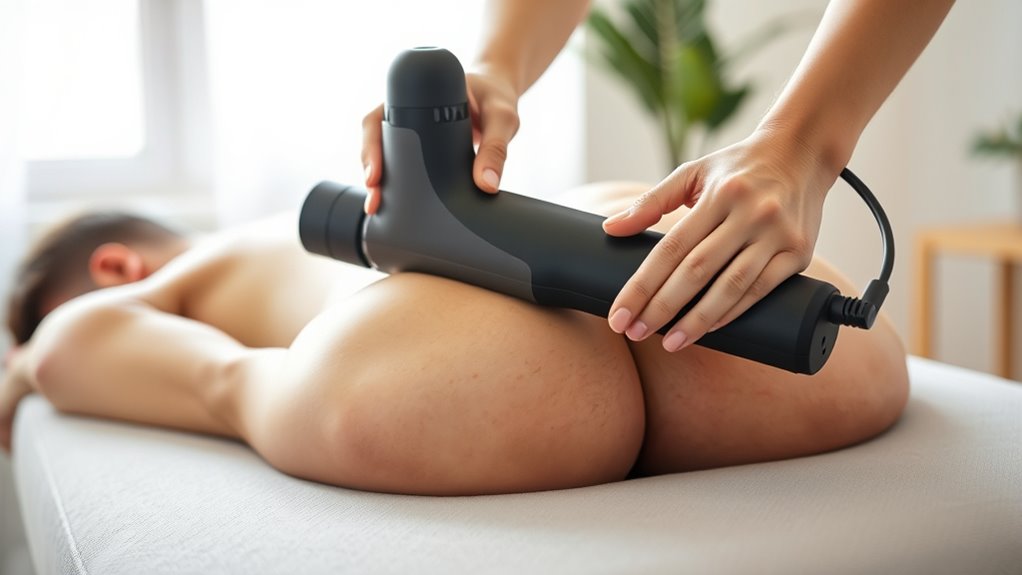
Using a massage gun for sciatica relief requires gentle, deliberate techniques to guarantee effectiveness and prevent discomfort. Start with light pressure and move slowly over trigger points and fascia areas. Focus on small circles or slow strokes, never rushing. Keep the device perpendicular to your skin, avoiding bony areas. Use short, controlled sessions—about 1-2 minutes per spot. Always listen to your body; if you feel pain or excessive soreness, stop immediately. Incorporating passive voice detection into your technique can enhance clarity and ensure your instructions are straightforward. Here’s a quick guide:
| Technique | Target Area | Duration |
|---|---|---|
| Gentle circular motion | Trigger points near sciatic nerve | 1-2 minutes per spot |
| Light fascia release | Glutes and lower back | 1-2 minutes |
| Slow stroking | Entire affected area | 2-3 minutes |
| Vary pressure levels | Sensitive spots | Adjust as needed |
| Rest intervals | After each area | 30 seconds to 1 minute |
Recognizing Signs of Overuse or Discomfort
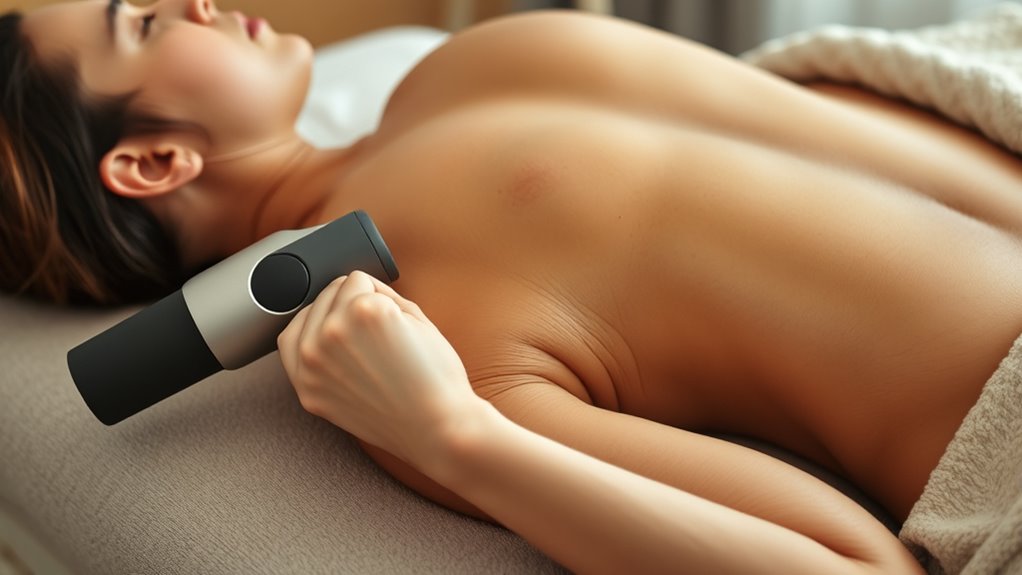
Pay close attention to how your body responds during massage gun sessions, as overuse or discomfort can quickly arise if you’re not careful. Signs of overuse include persistent soreness, numbness, or tingling beyond the treated area, which may indicate you’re applying too much pressure or using the device too long. Proper posture during sessions helps prevent unnecessary strain, while maintaining good hydration habits supports muscle recovery and reduces discomfort. To recognize issues early, watch for:
- Unusual pain or increased nerve sensitivity
- Persistent muscle soreness after sessions
- Tingling or numbness that worsens over time
A helpful approach is to monitor your body’s reactions closely, ensuring you adjust your technique as needed to avoid aggravating nerve pain. If you notice these signs, reduce your session duration, adjust pressure, or stop entirely. Listening to your body is key to safe and effective massage gun use.
Combining Massage Gun Therapy With Other Pain Management Strategies
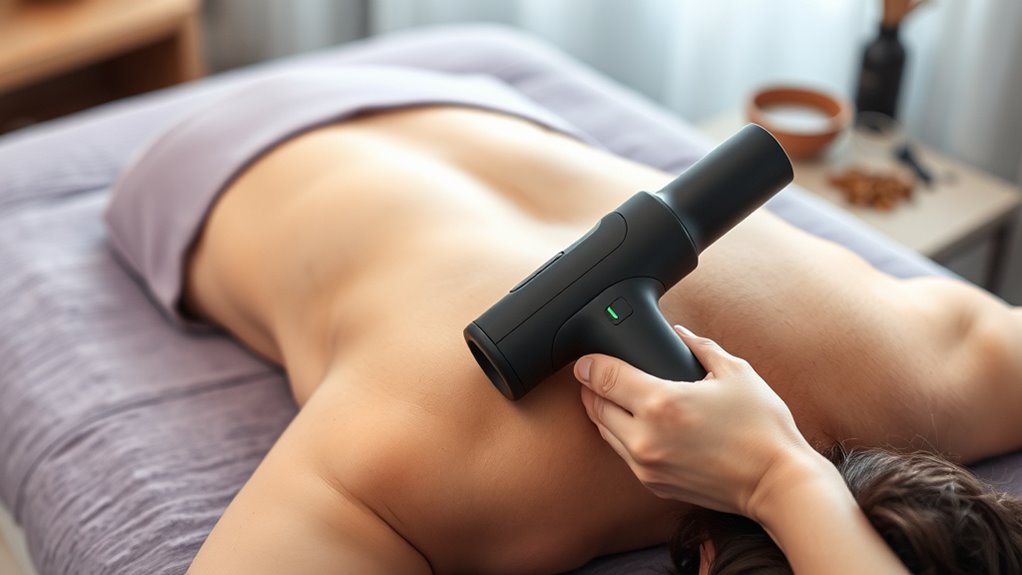
Combining massage gun therapy with other pain management strategies can enhance your overall relief and support faster recovery. Integrating alternative therapies and lifestyle adjustments creates a thorough approach to sciatica relief. For example, pairing massage with gentle stretching, improved posture, or heat therapy can amplify benefits. Consider this table to visualize your options:
| Strategy | How it helps | Best when combined with |
|---|---|---|
| Acupuncture | Reduces nerve inflammation | Massage gun therapy |
| Physical therapy | Strengthens supporting muscles | Lifestyle adjustments |
| Heat/cold therapy | Alleviates pain and reduces swelling | Alternative therapies |
| Yoga or stretching | Enhances flexibility and reduces tension | Massage, lifestyle changes |
| Medication | Manages acute pain | Use with cautious guidance |
This holistic approach empowers you to manage sciatica effectively. Additionally, understanding the role of nerve inflammation in pain can help you target treatments more precisely.
Tips for Incorporating Massage Guns Into Your Routine Safely
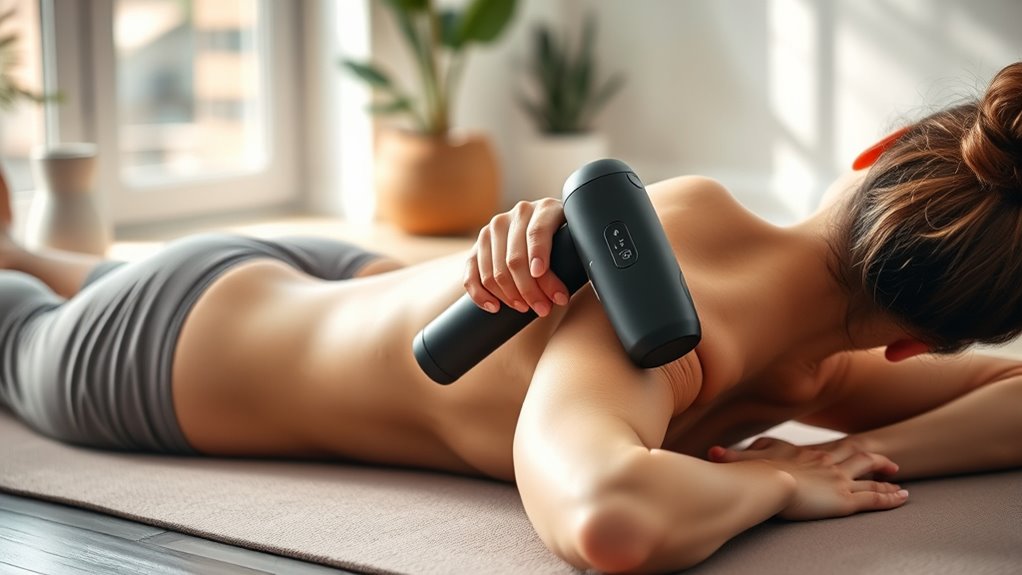
Incorporating massage guns into your pain management routine can be highly effective when done safely and thoughtfully. To maximize benefits and prevent injury, focus on proper massage gun maintenance and patient education. Always start with a low intensity and short duration, gradually increasing as your body adapts. Keep the device clean and charged to guarantee safe use. Additionally, be aware of retail hours today to plan your shopping for supplies or professional services that can support your therapy.
Use massage guns safely with proper maintenance, gradual intensity, and attentive listening to your body’s responses.
Consider these tips:
- Learn proper technique: Educate yourself on safe massage gun application, avoiding sensitive areas and nerve clusters.
- Limit usage time: Use the device for 1-2 minutes per muscle group to prevent overstimulation.
- Listen to your body: Stop immediately if you experience pain, and consult a healthcare professional for personalized advice.
Frequently Asked Questions
Can Massage Guns Permanently Cure Sciatica?
You might wonder if massage guns can permanently cure sciatica. While they can provide relief, especially with proper massage techniques, they don’t offer long-term solutions. Regular use may reduce nerve pain temporarily, but addressing underlying causes is essential for lasting relief. To truly manage sciatica, combine massage therapy with exercises or consult a healthcare professional. Massage guns are helpful tools, but they aren’t a permanent cure.
Are There Specific Massage Gun Brands Recommended for Nerve Pain?
When choosing a massage gun for nerve pain, you should look for brand recommendations known for quality and safety. Focus on device features like adjustable speed settings, multiple attachments, and ergonomic design to target nerve pain effectively. Brands like Theragun and Hyperice are popular choices, offering reliable devices. Make sure to select a model with gentle yet powerful settings, and always use it as directed to avoid overstimulation or discomfort.
How Often Should I Use a Massage Gun for Sciatica Relief?
Fostering frequency flexibility, you should start slow and steady. Follow the recommended guidelines for safe usage tips, typically using your massage gun for about 10-15 minutes per session, 1-2 times daily. Pay attention to your body’s signals, and avoid overdoing it to prevent irritation. Consistent, cautious application can help soothe sciatic nerve pain without overexertion or discomfort, ensuring safe and effective relief.
Can Massage Guns Cause Nerve Damage if Used Improperly?
You might wonder if massage guns can cause nerve damage if used improperly. Yes, if you ignore your nerve sensitivity or use the device on a malfunctioning setting, you risk nerve injury. Always read the instructions, start with gentle pressure, and avoid prolonged use over sensitive areas. If you notice pain or discomfort, stop immediately. Proper use minimizes risks and protects your nerves from potential damage.
Are There Any Contraindications for Using Massage Guns With Certain Medical Conditions?
Ever wonder if certain medical conditions make using a massage gun risky? You should know that yes, some medical contraindications exist. Conditions like blood clotting disorders, skin infections, or nerve damage require extra caution. Always follow safety precautions, and consult your healthcare provider before use. Ignoring these warnings could worsen your condition or cause harm. Stay informed and prioritize safety to enjoy the benefits without unnecessary risks.
Conclusion
Using a massage gun can substantially ease sciatica pain when done safely. Remember, about 60% of people with nerve pain find relief with regular, gentle therapy. Always choose the right settings, target safe areas, and listen to your body. Incorporate it into your routine gradually, and don’t hesitate to combine it with other treatments. With proper use, you can enjoy relief and improved mobility—making pain management more effective and less stressful.
